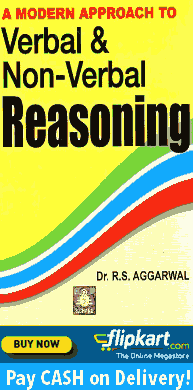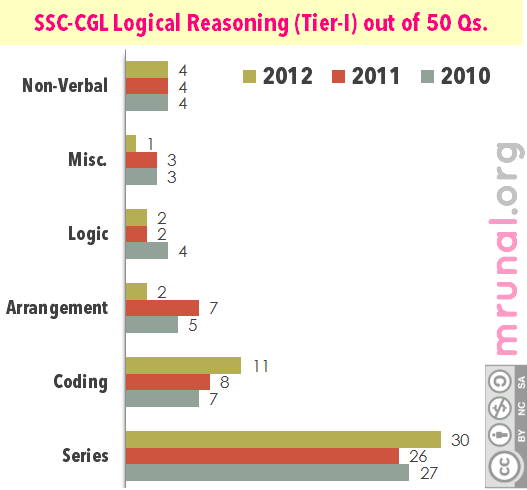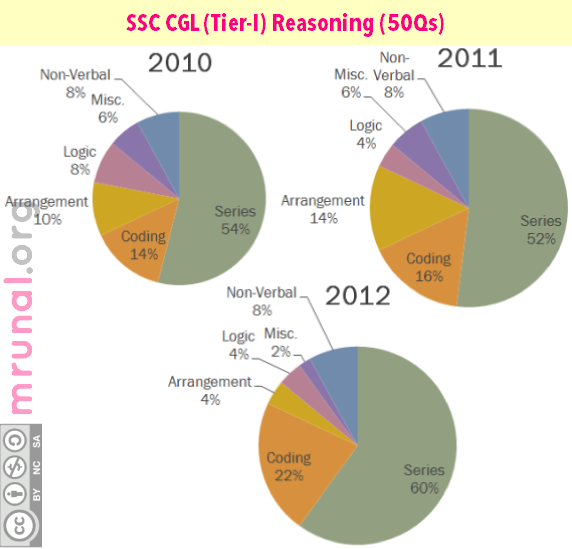- Reasoning, General Intelligence (Tier 1)
- Breakup : Last three years’ papers
- Priority order
- Task #1:Series
- Task #2: Arrangement-Direction tests
- Task #3: Non-verbal
- Task #4: Coding-Decoding
- Task #5 remaining stuff
- Book for Reasoning?
In the previous articles we saw how to approach
| General Awareness for Tier I | Click me |
| Maths / Quantitative Aptitude for Tier I and II | Click me |
| Reasoning / General Intelligence for Tier I | Click me |
In this last article on SSC-CGL series, we’ll see how to approach Reasoning (for Tier 1) and English (for Tier 1 and 2).
Reasoning, General Intelligence (Tier 1)
Just like how we did the Maths- first we’ll divide [Reasoning] into subtopics
Topic |
Subtopics | 2010 | 11 | 12 |
Series |
|
27 | 26 | 30 |
Coding |
|
7 | 8 | 11 |
Arrangement |
|
5 | 7 | 2 |
Logic |
|
4 | 2 | 2 |
Misc. |
|
3 | 3 | 1 |
Image based (non-verbal) |
|
4 | 4 | 4 |
Total |
Total | 50 | 50 | 50 |
Breakup : Last three years’ papers
Priority order
- Logical Reasoning portion doesn’t have much theory/formulas as such, except for Syllogism, clock-Calendars, Permutation combinations etc. so the only way to master Reasoning= via maximum practice at home.
- Here comes the problem: You’ve to face Reasoning/General Intelligence only at the tier-I stage. (50Q) But In tier II: there is no reasoning, but only Maths +English. Besides, you don’t have to tick 200/200 questions in tier-I, to pass the exam.
- So, you should have some sort of strategy about how much time and energy should be invested in Logical Reasoning portion. (like in General Awareness , the priority order was Static>>Science>>Crap.)
Task #1:Series
- As you can see from the topic wise breakup charts given above, majority of the questions are asked from “series”(analogy, odd pairs, dictionary etc). Around half of the reasoning questions are based on this topic only.
- In fact in every SSC- CGL paper, first 8-9 question are from analogy, next 7-8 question from “Find odd word/number” and so on.
- Therefore, I suggest you first solve all the sums related to “series” from your reasoning book. And within that, more emphasis should be given to
- Analogy (words and numbers)
- odd pair (same)
- classification
- dictionary based series
- inserting missing characters
- logical sequence of words
The word based analogy/odd pair is very easy (compared to number based or letter based).
But number based analogy/odd pair etc. can be a tough cookie.
So while in exam, keep an eye on wrist watch. Don’t spend too much time in just one question.
For example: find Missing number in the box?
| 3 | 7 | 52 |
| 5 | 11 | 126 |
| ?? | 9 | 107 |
Answer choice:
- 6
- 18
- 26
- 36
- If you’re able to solve this quickly=well and good.
- But sometimes the logic behind above number pairing won’t click in your mind immediately in the exam. So there is no point in wasting 5-7 minutes in just one question here. Just leave it and move on to next question.
- On the last page of your question paper (space for rough work), write down the Question number of such “time-consuming” sums and leave them for the end part of exam. (same advice for coding-decoding).
Task #2: Arrangement-Direction tests
- This includes blood-relation, arrangements (circular, line, building etc.)
- To a new player, the arrangement questions may appear time-consuming. But once you’ve practiced enough sums, your speed will improve.
- But the best thing with arrangement question= you can verify the answer (by applying the “conditions” given in the question to your arrangement).
- Easiest of all arrangement is circular arrangement. I consider it “no-excuse” topic. Solve each and every sum given in your book. Once you’re comfortable with circular, move to linear and rectangular (dining table).
- Next comes, Direction based question. Mohan walks 5 km north then… Again “no-excuse”. Solve each and every sum given in your book.
- Then building-car-job, lecture schedules etc. arrangements.
- Finally blood relations.
Task #3: Non-verbal
Image based question. Again no excuse, solve all the sums and it won’t pose much difficulty during exam. But yes keep an eye on wrist-watch.
Task #4: Coding-Decoding
This involves
- Typical coding decoding (PEAR written as GFDN then REAP is written as..)
- Symbols (circle is greater than, square is less than..)
- Maths operations (L=x, M=+, then value of 16L(12M13) is..)
- And other misc. questions.
Math operation =no excuse. Can be mastered with practice and can be solved quickly and accurately. Same for symbol.
So practice as much as you can.
Task #5 remaining stuff
- Here, first finish Syllogism (All cats are dogs..): use the UP-UN method to quickly solve them. click me to learn it. Please note, in SSC, at most two questions on syllogism per year. But cost-benefit ratio is very good. So don’t avoid).
- Conventional Venn Diagram questions. (50 drink coffee, 40 drink tea…) Usually just 1 question comes. Good part= answer can be verified and once you practice enough it doesn’t even take one minute to solve it (2 circle venn diagram cases).
- Therefore, no excuse must be prepared.
Now once you’ve done Above things then spend remaining time in whatever topics are left. Clock, calendar etc. (based on time and mood.)
Book for Reasoning?
- Since Reasoning/ General Intelligence topic doesn’t have much theory, the only way to approach it= practice maximum number of questions at home from your reasoning book.
- I’m going to repeat the advice given in maths article: You should simultaneously appear for IBPS, LIC, CDS, CAPF and all such exams depending on your career taste. (because putting all eggs in one SSC basket= bad idea sir-ji).
- So you want to use one reasoning book that is universally applicable to all such exams. I suggest use either one of the following books:
 |
 |
|
| Book | A Modern Approach to Verbal and Non Verbal Reasoning by | A new approach Verbal and Non Verbal Reasoning by |
| Author | R.S.Agarwal | BS Sijwali |
| Publication | S.Chand | Arihant |
- While content and coverage is almost the same in both these books, They differ mainly in terms of “size” (=no. of practice questions given in each book.).
- BS Sijwali has less number of practice question (around 750 pages) while R.S.Agarwal’s reasoning book has about 1500 paper.
- Both of them quite helpful in SSC-CGL, IBPS, LIC-ADO, AAO, CDS, and similar exams.
- You don’t need to use both of them, just use any one of them. And practice as many questions as you can at home.
- This concludes the discussion on How to approach Logical Reasoning/ General Intelligence for SSC-CGL exam.
- Now only one topic remains: how to approach English vocabulary, grammar and comprehension. Will be discussed in a separate article.



![[SSC] CGL 2014 Tier-2 Result, Cutoff, Answerkeys out, Interviews to begin in June, Tips for Typing Test](https://mrunal.org/wp-content/uploads/2015/05/c-t2-result-500x383.jpg)

![[Download] SSC Question Papers 2014 Tier 1: Both 19th & 26th October with Official ANSWERKEYS & UP-RO, CPO, T2-Stats](https://mrunal.org/wp-content/uploads/2014/10/Cover-SSC-2014-T1-Papers-500x383.jpg)
Wakai shaandaar fodtey ho sir aap,, hats off to you,, kabhi to milunga sir aapse
Please tell me reasoning book for ssc in hindi medium
How can solve this cat+cat+cat=rat
if c=3. a=0 r=9
Sir
Mere SSC m 91 bn rhe h but mene apni interview post preference galat bhar di plzzzz help me!!!!!!!!!!
i will also give 2015 civil exam..i want to knowabout the strategy n helpiNg books besides ncert..plz suggest how can i crack the exam
Information related to civil service is already given…
i am unable to download the notes plz tell me how can i downloads the notes
reasoning k liye best writer ki book konsi hai plz suggest kiziye
Its RS aggarwal…lot of question to practice with different types…
Anyone can please tell me any email resource for verbal and non verbal reasoning questions ?
SIR ,IS THERE ANY NECESSITY TO READ NCERT FROM 5 TO 12 TH FOR SSC CGL EXAMINATION ???????AND HOW MUCH TIME ONE WILL
REQUIRED FOR COMPLETION OF SSC CGL SYLLABUS…….PLZ SUGGEST ME REGARDING THE TIME MANAGEMENT……..
It will take 3 months bro…
Sir,..you posted ur calender problem code in youtube is not clearly visible, unable to watch …plzz make a bigger font size so we can read it properly
Sir can you suggest me the book in which I can get previous years papers of SSC cgl tier 1 with good explanation.there are many publication. So m confused.
Go for kiran prakshan book…undoubtedly the best…
thanq for your information sir
Perfect site for which i was looking for. I just want to thank you for all the information ptovided. It was really helpfull, cleared all my doubts. Really appreciated, thanks…
Dear Friends…..!
i need previous and upcoming exam paper models and syllabus for SSC CRPF Exam
so
please give me your valuable suggestion on how can i get this books…….!
Sir I am a commerce student am I able to write ssc cgl ofcourse tier 1 is ok what about tier2. Plzzz help me any one motivate me about cgl its my first step
R/sir
i want to know is there any change in syllabus of ssc cgl 2015 ( Tier-1 )
plz reply soon so that i can prepare…
thankyou
not interested
Hello sir, I m good in mathematics but when I solved QP I found problem in word anology problems.sir please tell me solution
Self study k liye koi books jo ki hindi me ho
mere ko ssc ki taiyari karni kaise karna padega . kaise padhai karni padegi kaon2 se book padhani hogi.
Sir tell me about the process of ibps
Hello Sir,
What should I follow for General awareness: ‘General Knowledge Manual – Pearson Publication’ OR ‘Lucent’s General Knowledge’ and why?
It’s happens, try again ,,,,
Hae¦¦¦¦a=0 given then
LHS=RHS=0
I.e cat+ cat+ cat= rat
Sir can u give me a suggestion m zero in maths BT I want to clear the ssc exam so give me a suggestion if I m zero in maths so can I manage this so can I clear the ssc exm
Dear Sir….first of all Thanxx alott to you for yr excellent work for dis page for d students.
Sir, can u tell me dat for SSC LDC exam 2015…for d GK portion…which Class Book of NCERT should i pay more attention excluding Current Affairs…to score maximam marks in GK??
Becoz in 3 months To complete Class 7-12 syllabus…nt to easy..
For reasoning I have Mk pandey 2000 edition. Is it sufficient to go for SSC cgl 2016 reasoning.
sir, plz update the gk, eng, arthematic for 2015 & 2016
I am preparing for SSC Multitasking Non-Technical Services exam. How will I get good score in reasoning and english?